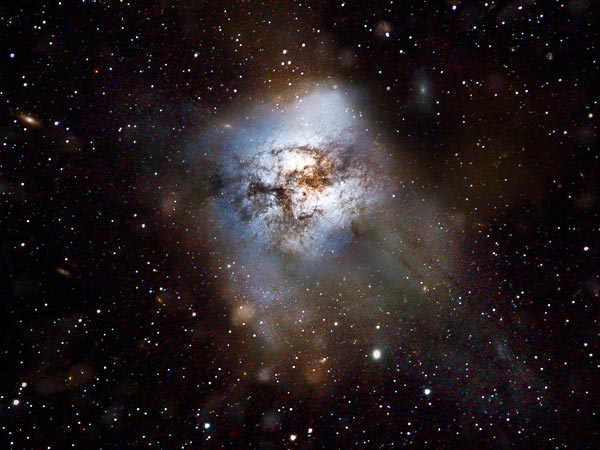Starburst Galaxy Could Illuminate Early Universe
A newfound primordial galaxy nearly 13 billion light-years away is breaking distance records and may unlock the secrets of how and when some of the most massive star factories were born in the early universe, according to a new study.
Using the infrared mapping capabilities of the European Space Agency's Herschel space telescope, a team of astronomers have spied the faraway light of a starburst galaxy—one that exhibits a high rate of star formation—from when the 14-billion-year-old universe was just 880 million years old.
Dubbed HFLS3, the galaxy—which is the farthest starburst galaxy yet found—was caught in the act of forming and pumping out new stars at unheard of rates more than a billion years earlier than expected.
"This newly discovered galaxy is pushing the extremes in virtually every aspect of its existence," said Dominik Riechers, an astronomer at Cornell University in Ithaca, New York, and lead author of the new paper published April 17 in the journal Nature.
An illustration of a starburst galaxy, similar to one—dubbed HFLS3—recently found by researchers.
"It is not only the earliest we have discovered, but also one of the most intensely star-forming, even among its peers that exist at later epochs," he said.
While its overall size is estimated to be similar to the size of our own Milky Way, scientists were stunned to find that the starburst galaxy is churning out matter with the mass equivalent of 2,900 suns every year.
"It forms stars at a rate more than 2,000 times that of our own Milky Way, and close to the limit where it can stay stable in light of the intense, plentiful, high-energy radiation emitted by the many newly formed young stars," Riechers added.
A Messy Youth
Despite being enshrouded in dust and so near the edge of the cosmos, HFLS3 appears unusually bright, radiating in infrared wavelengths that shine with a power equivalent to 30 trillion suns.
This tipped off the researchers that they must have discovered a massive starburst galaxy, because the celestial object could shine so brightly only because of unusually high star-formation activity.
Another surprise for Riechers and his team was that spectroscopic measurements, which reveal the galaxy's chemical fingerprints, indicate that it possesses a rich and diverse chemical composition, similar to present-day starburst galaxies.
Because most of the heavier elements, like carbon and iron, are thought to have formed from the ashes of the first generation of stars in the universe, astronomers have speculated these atoms should be absent in the first billion years or so after the Big Bang.
"This is an indication that the intense star formation in [HFLS3] has already been going on for a significant amount of time, long enough for the shortest-lived stars to explode and pollute their environments with all the heavy elements that we see," said Riechers.
Galactic Embryo
Until now, starburst galaxies—thought to be responsible for the rapid buildup of most of the stars that make up a lot of today's massive galaxies—were thought to form only at much later time periods than HFLS3.
"While only at later times did most larger galaxies start to form and accumulate sufficient gas to become prolific star factories, this discovery shows that, under exceptional circumstances, the most intense star-forming events in the universe can take place as early as 880 million years after the Big Bang, enabling the formation of mature, massive galaxies very early on," said Riechers.
This unexpected finding starts to explain why we currently see some of the oldest known stars residing in elliptical galaxies, said Chris Carilli, an astronomer with the National Radio Astronomy Observatory headquartered in Charlottesville, Virginia.
"We now see why: They formed a long time ago," said Carilli, who was not involved with the study. "Distant starbursts likely represent the formation of elliptical galaxies in spectacular, explosive events in the early universe."
These most massive galaxies, or ellipticals, are currently found at the centers of large galaxy clusters. So HFLS3 is likely the galactic embryo of such a present-day massive, central cluster galaxy, said Carilli.
"These observations have pushed the whole process of massive galaxy formation back to the edge of 'first light' in the Universe," he added.(Andrew Fazekas.for National Geographic News.Published April 17, 2013)












